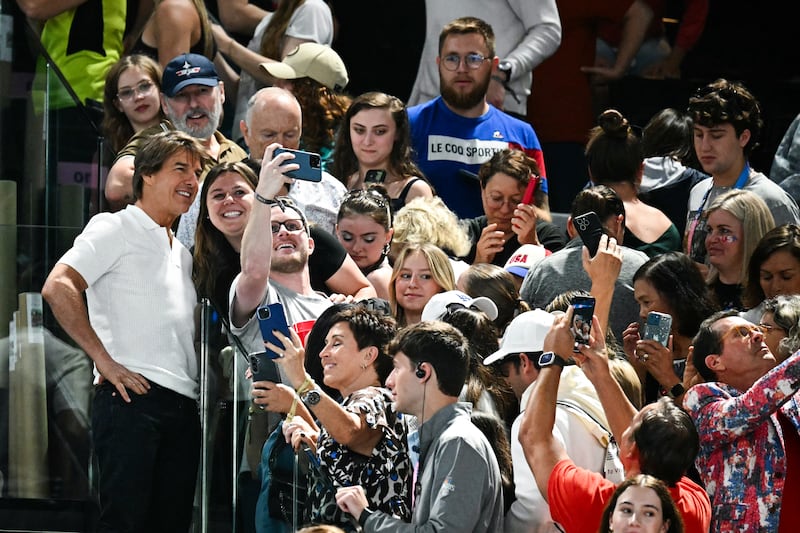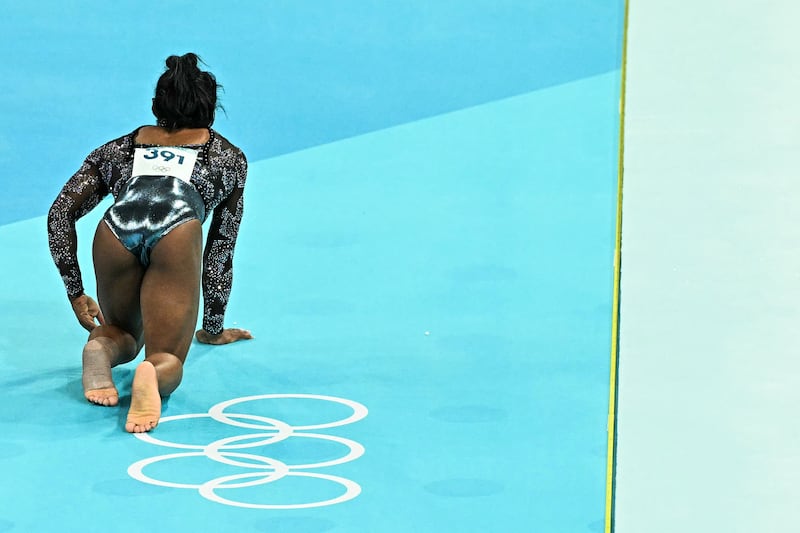As Simone Biles offered herself a few final quiet words of encouragement by the balance beam before she returned to compete in front of the world once again, the entire spectacle could have been so overwhelming. The Bercy Arena was already exploding with excitement whenever her name was mentioned. Countless celebrities, from Tom Cruise to Ariana Grande, lined the stands and flashed up on the screens. All eyes were on Biles, and she knew it.
The competition draw that Biles and her US team-mates received was also unhelpful. They were required to start on the balance beam, the most unpredictable apparatus and the event that exposes all tension and uncertainty. If you cannot control your nerves, you will fall.
But Biles effortlessly worked her way through a smooth, efficient opening beam routine without a flicker of uncertainty. That first routine would set the tone for a spectacular return to Olympic competition as she finished her subdivision of women’s qualification as the top all-around qualifier, scoring 59.566. It is the biggest international all-around score of the Olympic quad and with three more subdivisions to come, there is not a soul who can outscore her.

In addition to her all-around score and the US team leading the way, Biles currently occupies the top spot on the vault, she is second on the balance beam and number one on floor. Even on the uneven bars, where she is not as strong, Biles sits in eighth place.
READ MORE
Despite her excellent performance, Biles finished her first day of competition with concerns about a calf injury she managed after she looked in visible discomfort during her time on the competition floor.
Cécile Canqueteau-Landi, Biles’s coach, explained afterwards that Biles had “just a little something in her calf”, pain she had felt a few weeks earlier before it flared up again during the competition. Asked if there were any concerns over her not competing, Landi said: “Never in her mind, no.”
Throughout the subdivision, the second of five, there were numerous potential road bumps for the US team. Just before Biles began on the floor exercise, Jade Carey, the reigning Olympic floor champion, performed a watered down routine and then bailed out of her final tumbling pass. Biles was charged with immediately following up her team-mate, but Biles calmly produced a brilliant floor routine.

While Biles had taken her triple twisting double back somersault – the Biles II – out of her routine of last year, she landed it comfortably and even slightly overpowered the skill, smiling as she took a small step out of bounds. Although she has room to improve, Biles’s floor exercise score of 14.6 has only been matched internationally by Andrade during this Olympic cycle.
Things can unravel so quickly in gymnastics, particularly when injuries are involved, and there was immediate cause for concern as Biles was warming up for the vault. After one attempt, she crawled and then limped back to the start of the vault runway. Moments later, Biles attempted her Yurchenko Double Pike vault – the Biles II – but landed it short, falling to her knees.
While she was clearly in pain, her ankle and calf heavily taped, Biles still appeared to be in good spirits as she smiled, chatted with her team-mates and seemed to reassure everyone that she was okay. Then she sprinted down the runway and produced a supreme Yurchenko double pike vault, her first time doing so in Olympics competition. Biles’s second vault, the Cheng, was big and she finished with an average vault score 15.3. No other woman has averaged more than 15 points during this Olympic cycle.

After completing a calm and easy uneven bars routine, Biles finally allowed herself to look out to her audience of 20,000, most of whom had come to see her, and she waved to each side of the stadium with a chuckle as her redemption tour began with a spectacular performance.
Three other members of the US Tokyo 2020 team competed alongside Biles on Sunday: Sunisa Lee, Jordan Chiles and Jade Carey, each gymnast on their own redemption run after finishing with a silver medal three years ago. The presence of Lee, the Tokyo 2020 women’s all around champion, is particularly notable. Now 21, Lee has had a difficult time since then after attempting to compete as a college gymnast and then suffering a serious kidney illness last year.
At times it seemed unlikely that she would even be in contention for Paris, but Lee made it back just in time for Paris and her score of 56.132 means she now sits in second place behind Biles and will be one of the highest all around qualifiers. Lee can also compete for medals on the floor exercise and uneven bars. While Chiles sits in third place, just .067 behind Lee, only two gymnasts per country can compete in the all around final.
The first subdivision showcased another special return. Over the past three years, Great Britain’s Becky Downie has had to digest the tragic sudden death of her younger brother, which occurred the day before she was scheduled to compete in the Tokyo Olympic trials, the blowback she and her sister received after whistleblowing on abuse within gymnastics, numerous major injuries and not being selected for the Tokyo Olympic team. Still, she remained determined to see if she could fulfil her goal of becoming an Olympic medallist.
Early on Sunday morning, Downie stepped up and nailed her incredibly difficult bars routine, scoring 14.666. As the 32-year-old stepped off the competition podium, Downie could not hold back the tears of relief and joy. She will wait to see if she makes the uneven bars finals and after a mixed day for the Great Britain women’s team overall, they must also wait to see if they can qualify for the team finals. – Guardian













